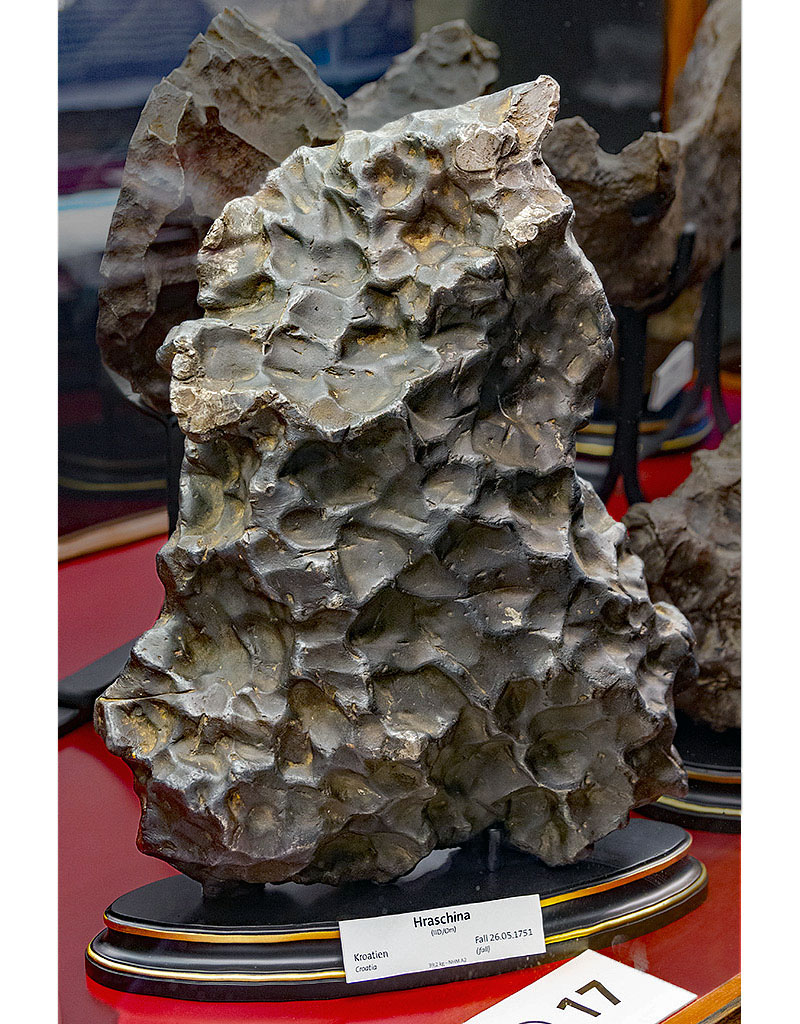|
Roll Overs:
1
2
3
4
5
|

|
|
Herbert Raab. Copyright (c) Herbert Raab.
|
Find/Fall Anniversary |
Iron, IID
TKW 49 kg. Observed fall 26 May 1751, Croatia.
  buchlink buchlink
Herbert writes:
The Hraschina iron meteorite fell on May 26, 1751, i.e., 270 years ago on this day.
In the late afternoon sky over Coratia (then part of the Austrian-Hungarian empire), a fireball appeared, which, with loud detonations, split in two parts. Two iron meteorites, weighting 88 and 20 pounds, respectively, were recovered. Accompanied by a protocol that provided an outline of the observations of several eyewitnesses, the larger mass was sent to Vienna, where it was included in the natural history collection of Franz I. Stepahn, husband of empress Maria Theresia. Part of the smaller mass was used by locals to forge nails, and the remaining specimen has subsequently been lost.
Referring to the Hraschina fall, Abbé Andreas Xaverius Stütz, then assistant director of the empirial natural history cabinet (the predecessor of Vienna's Natural History Museum) wrote in 1794:
Those who are ignorant of natural history may believe that iron has fallen from the sky, even Germany's more enlightened minds may have believed so in 1751, given the uncertainty prevailing among us in natural history and physics at that time; but in our time it would be unforgivable to find such fairy tales even likely.
Although sceptical about the true nature of the meteorite, Stütz fortunately kept the specimen in the collection, and it became the founding stone of what is now the meteorite collection of the Natural History Museum in Vienna - the collection with the longest history of all major meteorite collections in the world.
Photo 1 shows the 39.2 kg main mass, as currently displayed in the Natural History Museum, Vienna.
Photo 2 shows a slice from the Hraschina meteorite. This is one of the samples that was heated in 1808 by Count Alois von Widmanstätten, when he discovered the crystalline pattern in meteoritic iron that is now named after him.
Photo 3 shows the Hraschina meteorite as displayed in the Natural History Museum in 2009, with a facsimile of the protocol of the eyewitness accounts in the background.
Photo 4 shows a plate from Wilhelm Karl Ritter von Haidinger's 1859 publication about the Hraschina fall. The paper includes a translation of the protocol (that was originally written in Latin) to German. The plate shown here reproduces the drawings from the protocol: On top is a "three dimensional" representation of the fall, as it appeared in the sky: From a cloud near the zenith, lighting bolts are emitted, and two fireballs drop, while the sun is setting in the west (occident). The lower half of the plate shows the development of the smoky trail that appeared after the fireball. The "star" that appears besides the cloud in figure No. 3 is the planet Venus.
Photo 5 shows two figures from the mineral hall at the Natural History Museum Vienna. The figures in that hall represent various minerals and metals. While the caryatid at right stands for Silver, the male figure at left represents the meteorites: It seems to throw a meteorite from the sky down to the Earth. The meteorite is, in fact, a cast of the Hraschina meteorite.
All photos, except photo 4, were taken at The Natural History Museum in Vienna. It is the policy of the NHM to allow visitors to photograph the exhibits, but only for personal use. Pictures cannot be used for commercial purposes without written permission. The MPOD is in the personal use category so showing these pictures here is allowed. |
Click to view larger photos
#1
#2
#3
#4
#5
|
Found at the arrow (green or red) on the map below
|
|
| |
Mark Grossman
5/26/2021 2:10:36 PM |
There's more information on St*tz, Tabor, and Hraschina in my May 2011 Meteorite Magazine article "Joseph Stepling and the Tabor meteorite fall." The full text is available of researchgate.net. |
Anne Black
5/26/2021 1:40:54 PM |
I have been there, but I didn't know about those 2 statues. Thanks Herbert. |
Andi Koppelt
5/26/2021 1:54:55 AM |
Spectacular iron. Thanks, Herbert, for this nice abstract. |
| |
|